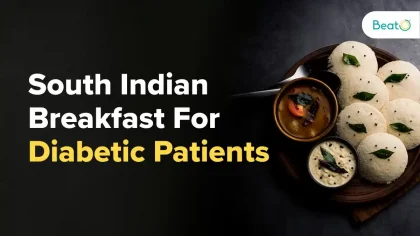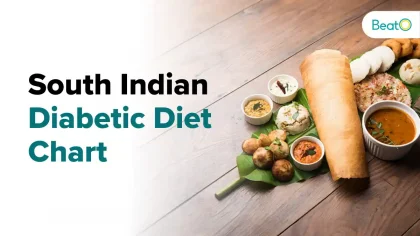Are you or someone you know having trouble finding enticing, wholesome South Indian Breakfast For Diabetic Patients? Well, no need to worry! Here, we’ve presented a list of South Indian cuisine that provides a wealth of breakfast options that can be both filling and diabetic-friendly. In addition, South Indian cuisines are rich in flavours and wholesome ingredients and, if adopted, can support a balanced and healthy start to your day while keeping your blood sugar levels in check. Moreover, eating right and on time is also necessary for diabetes patients.

Also read: The Ultimate Guide To South Indian Diabetic Diet Chart
List of 10: South Indian Breakfast For Diabetic Patients
Here is the list of South Indian breakfasts for diabetic patients that you’ll love to start your morning with. Let’s explore some mouth-watering options that are as delightful as they are beneficial!
| S.No | Breakfast Option |
|---|---|
| 1. | Ragi Wheat Dosa |
| 2. | Kancheepuram Idli |
| 3. | Upma |
| 4. | Oats Idli |
| 5. | Mushroom Uttapam |
| 6. | Beans Paruppu Usili |
| 7. | Quinoa Upma |
| 8. | Pesarattu |
| 9. | Kadala Curry |
| 10. | Lemon and Ginger Rasam |
Also read:7 Must-Try Vegan Dinner Recipe Ideas
1. Ragi Wheat Dosa
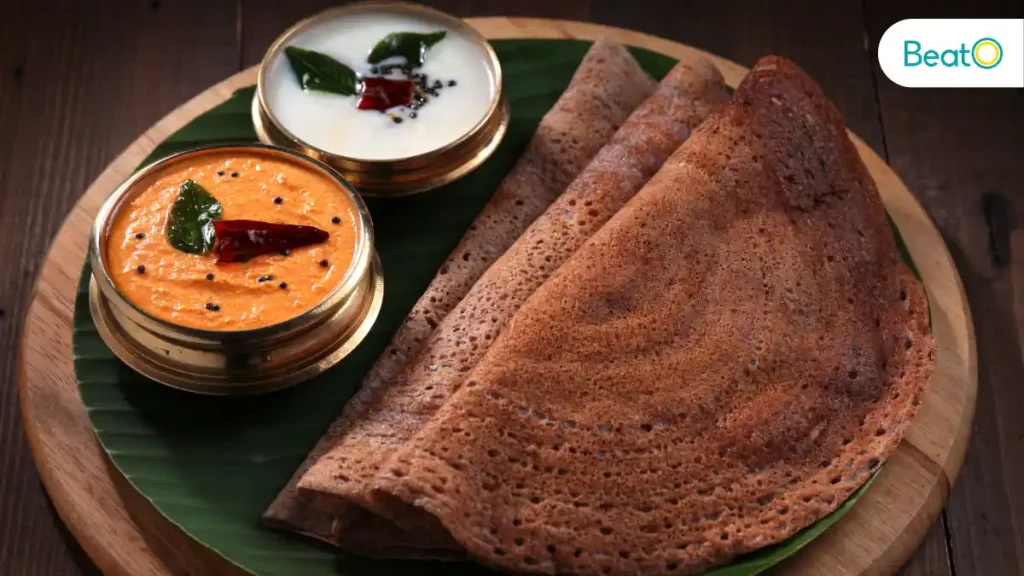
Ingredients:
- 1 cup ragi (finger millet) flour
- 1 cup whole wheat flour
- 1/4 cup urad dal (split black gram)
- Salt to taste
- Water for batter
- Oil for cooking
- Add vegetables of your choice ( To make it more nutritious )
Recipe:
- Soak and Grind: Soak urad dal for 4-5 hours. Grind to a smooth paste using a little water.
- Mix Batter: In a bowl, mix ragi flour, wheat flour, and the urad dal paste. Add salt and enough water to form a smooth, pouring consistency batter.
- Ferment: Cover and let the batter ferment overnight.
- Cook Dosa: Heat a non-stick pan and pour a ladle of batter, spreading it into a thin circle. Drizzle a few drops of oil around the edges.
- Cook Until Golden: Cook until the dosa turns golden brown on one side, then flip and cook on the other side.
- Serve: Serve hot with coconut chutney or sambar.
Benefits for Diabetics:
- Low Glycemic Index: It is one of the best South Indian breakfast for diabetic patients. Ragi and wheat are low GI foods, helping to maintain stable blood sugar levels.
- High in Fiber: Promotes slow digestion and prevents blood sugar spikes.
- Rich in Nutrients: Provides essential minerals like calcium and iron, beneficial for overall health.
2. Kancheepuram Idli
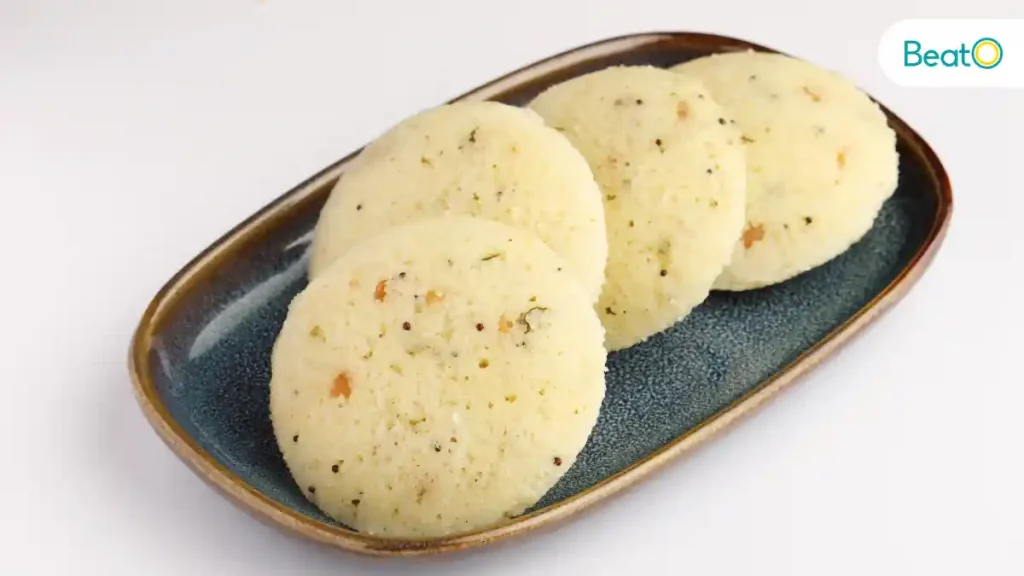
Ingredients:
- 1/4 cup urad dal
- 1 cup Yellow Lentil / Moong Dal
- ½ Tsp Fenugreek / Methi seeds
- 1- 2 Green Chillies
- ¾ Tsp Cumin seeds
- 10-12 Black peppercorns
- ½ Tsp Dry Ginger powder/ (sukku/sonti podi)
- Salt to taste
Recipe:
- Soak Ingredients: Soak urad dal, and moong dal separately for 4-6 hours.
- Also, soak Fenugreek seeds along with the dal.
- Grind Batter: Grind them together into a coarse batter. Mix in the peppercorns, cumin seeds, salt, and ghee.
- Ferment: Let the batter ferment overnight.
- Steam Idlis: Pour the batter into idli moulds and steam for 10-12 minutes or until a toothpick inserted comes out clean.
- Serve: Serve hot with sambar or coconut chutney.
Benefits for Diabetics:
- Steamed for Low Calories: Steaming reduces the calorie content, making it a light option.
- Fermentation Benefits: Fermentation helps in pre-digestion of the starches, aiding in better blood sugar management.
- Rich in Protein: Urad dal provides protein that is important for maintaining muscle mass and satiety.
Note: Kancheepuram Idli is one of the best South Indian Breakfast For Diabetic Patients and it is only made up of only dals. In addition, Avoiding rice helps prevent diabetes because it contains grains.
3. Upma
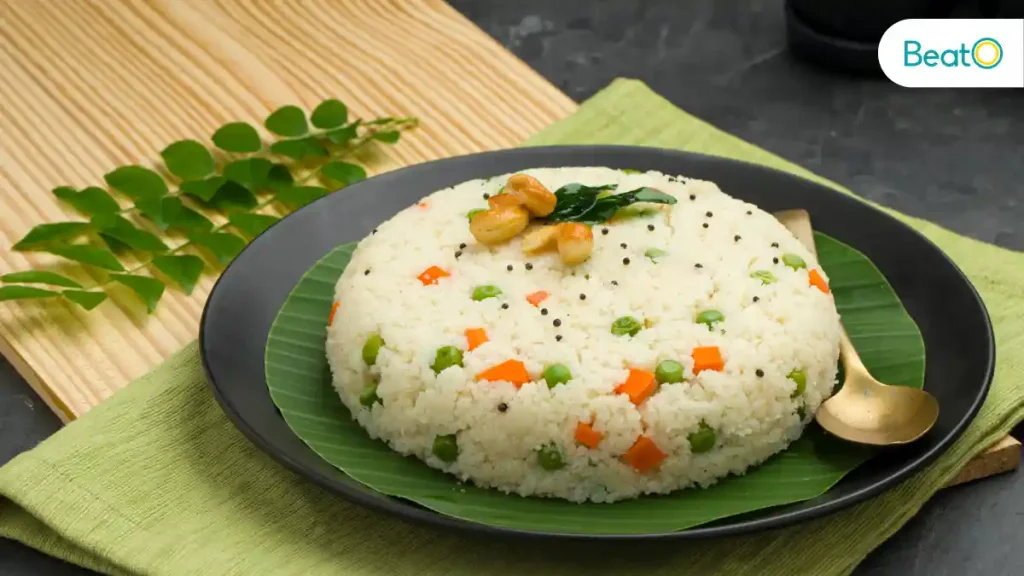
Ingredients:
- 1 cup semolina (rava)
- 1 onion, chopped
- 1 carrot, diced
- 1/2 cup peas
- 2 green chilies, chopped
- 1 tsp mustard seeds
- 1 tsp urad dal
- Curry leaves
- Salt to taste
- 2 cups water
- 1 tbsp oil
Recipe:
- Roast Semolina: Dry roast semolina until it turns light brown and set aside.
- Prepare Tempering: Heat oil in a pan, add mustard seeds, urad dal, and curry leaves. Add chopped onions and green chillies and sauté until the onions are translucent.
- Add Vegetables: Add carrots and peas and cook for 2-3 minutes.
- Cook Semolina: Add water and salt and bring to a boil. Slowly add the roasted semolina, stirring continuously to avoid lumps.
- Cook Until Done: Cook until the water is absorbed and the upma is cooked through.
- Serve: Serve hot with a squeeze of lemon juice and a side of chutney if desired.
Benefits for Diabetics:
- Low Glycemic Index: Semolina has a moderate GI, aiding in steady blood sugar levels.
- Rich in Fiber: Adding vegetables increases fibre, which is crucial for blood sugar control.
- Easily Digestible: This dish is quite easy to make, light on the stomach, and easy to digest.
4. Oats Idli
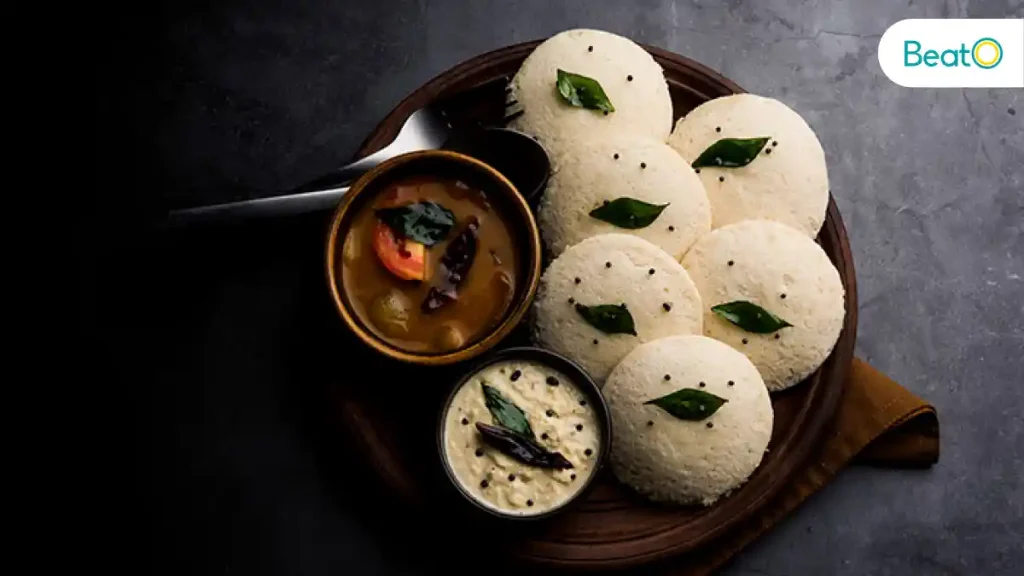
Ingredients:
- 1 cup rolled oats
- 1/2 cup semolina (rava)
- 1/2 cup curd (yogurt)
- 1/4 cup grated carrots
- 1 tsp mustard seeds
- 1 tsp urad dal
- Curry leaves
- Salt to taste
- Water as needed
- 1/4 tsp baking soda
Recipe:
- Prepare Oats: Dry roast oats until they turn slightly brown, then grind into a coarse powder.
- Mix Ingredients: In a bowl, mix oats powder, semolina, curd, grated carrots, salt, and enough water to make a batter.
- Prepare Tempering: Heat oil, add mustard seeds, urad dal, and curry leaves. Add this to the batter.
- Steam Idlis: Add baking soda to the batter, mix well. Pour the batter into idli molds and steam for 10-12 minutes.
- Serve: Serve hot with coconut chutney or sambar.
Benefits for Diabetics:
- High in Fiber: Oats are rich in soluble fibre, which helps control blood sugar levels.
- Heart-Healthy: Oats contribute to lowering cholesterol and are beneficial for cardiovascular health.
- Low Glycemic Index: Helps maintain stable blood sugar levels.
5. Mushroom Uttapam
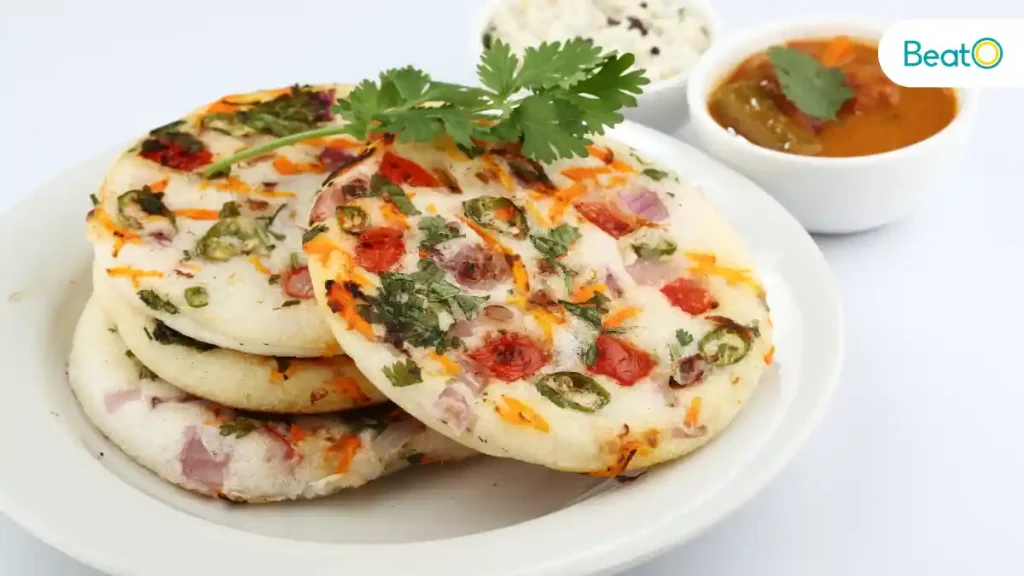
Ingredients:
- 1 cup dosa batter (store-bought or homemade)
- 1/2 cup mushrooms, sliced
- 1 onion, finely chopped
- 1 tomato, finely chopped
- 1 green chili, chopped
- Salt to taste
- Oil for cooking
- Corn
- Spinach
- Pepper
Recipe:
- Prepare Batter: Ensure the dosa batter is at room temperature and has the right consistency.
- Prepare Toppings: Mix mushrooms, onions, tomatoes, corn, spinach, pepper, green chili, and a pinch of salt in a bowl.
- Cook Uttapam: Heat a non-stick pan and pour a ladle of batter, spreading it into a thick circle. Sprinkle the vegetable mixture on top.
- Cook Until Golden: Drizzle a little oil around the edges and cook until the base is golden brown. Flip and cook the other side.
- Serve: Serve hot with coconut chutney or sambar.
Benefits for Diabetics:
- Rich in Fiber: The vegetables, particularly mushrooms, add fibre, aiding in blood sugar control.
- Low Glycemic Index: The dish has a moderate GI, making it suitable for diabetics.
- Nutrient-Rich: Provides essential vitamins and minerals from the vegetables.
6. Beans Paruppu Usili
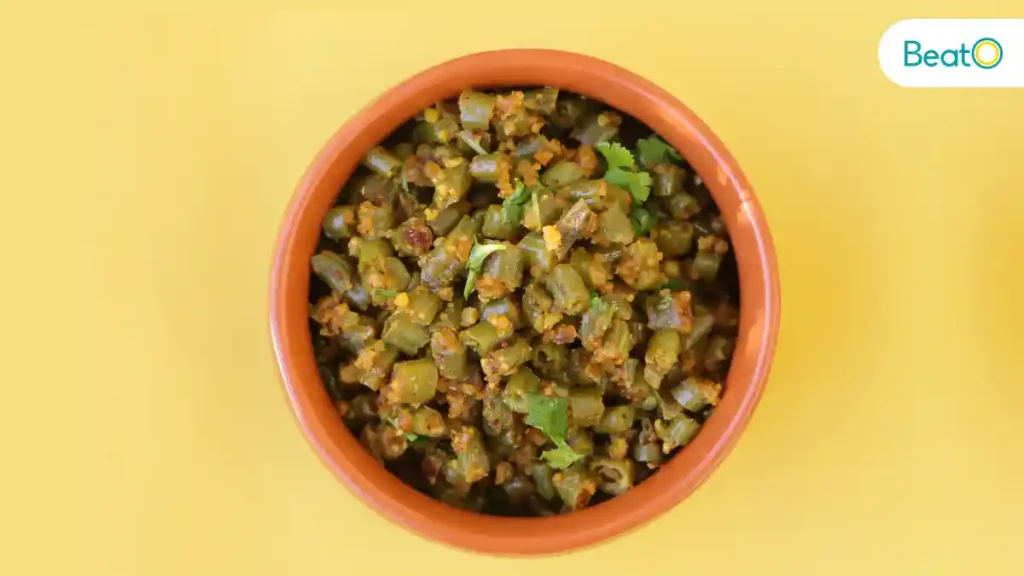
Ingredients:
- 1 cup green beans, chopped
- 1/2 cup chana dal (split chickpeas)
- ½ Cup toor dal
- 2 dried red chilies
- 1 tsp mustard seeds
- 1 tsp urad dal
- A pinch of asafoetida (hing)
- Curry leaves
- Salt to taste
- 2 tbsp oil
Recipe:
- Soak and Grind Dal: Soak the dals for 2 hours, then grind them with red chillies to a coarse paste.
- Steam Dal Paste: Steam the ground dal paste for 10 minutes, then crumble it.
- Cook Beans: Heat oil in a pan, add mustard seeds, urad dal, and curry leaves. Add chopped beans and cook until tender.
- Add Dal Mixture: Add the crumbled dal mixture and sauté until well combined and slightly crispy.
- Serve: Serve hot as a side dish or with steamed rice.
Benefits for Diabetics:
- High in Fiber: The combination of beans and dal provides significant fibre, helping to regulate blood sugar.
- Protein-Rich: Chana dal adds protein, which is essential for maintaining muscle and satiety.
- Low Glycemic Index: Beans and dal are low GI foods, ideal for blood sugar management.
7. Quinoa Upma
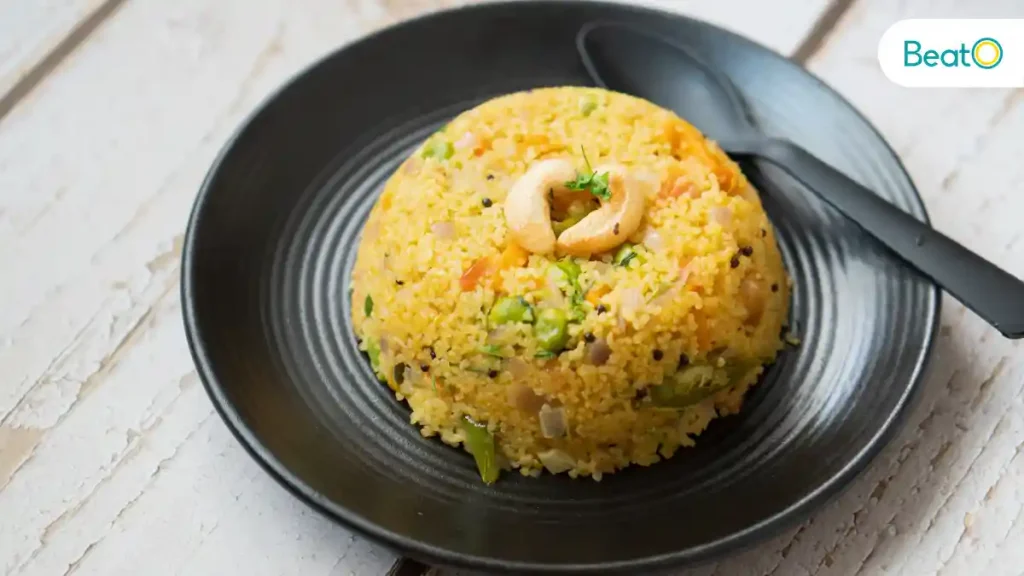
Ingredients:
- 1 cup quinoa
- 1 onion, chopped
- 1 tomato, chopped
- 1 carrot, chopped
- 1/2 cup peas
- 2 green chilies, chopped
- 1 tsp mustard seeds
- 1 tsp urad dal
- Curry leaves
- Salt to taste
- 2 cups water
- 1 tbsp oil
Recipe:
- Prepare Quinoa: Rinse quinoa and set aside.
- Prepare Tempering: Heat oil in a pan, add mustard seeds, urad dal, and curry leaves. Add onions and green chilies, sauté until golden.
- Add Vegetables: Add tomatoes, carrots, and peas. Cook for 2-3 minutes.
- Cook Quinoa: Add quinoa, salt, and water. Bring to a boil, then cover and cook on low heat until quinoa is tender and water is absorbed.
- Serve: Serve hot with a squeeze of lemon juice.
Benefits for Diabetics:
- High in Protein and Fiber: Quinoa provides essential amino acids and fiber, aiding in blood sugar control and satiety.
- Low Glycemic Index: Helps maintain stable blood sugar levels.
- Nutrient-Rich: Packed with vitamins, minerals, and antioxidants.
Also read:7-Day Vegan Diet Plan For Weight Loss: Is It A Myth?
8. Pesarattu
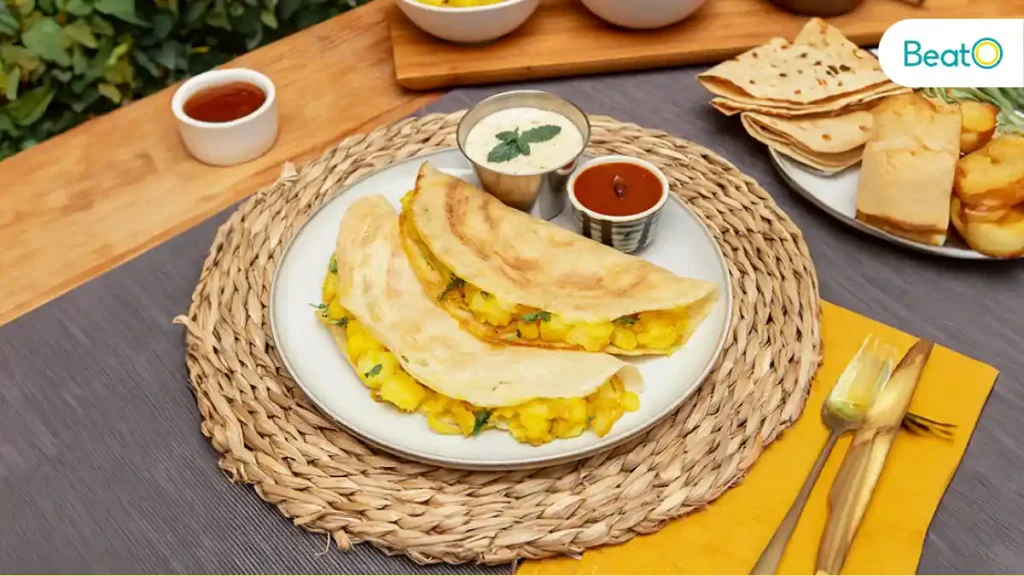
Ingredients:
For Pesarattu:
- 1 cup green gram (moong dal)
- 1/4 cup rice flour
- 1 onion, chopped
- 2 green chilies
- 1 inch ginger
- Salt to taste
- Water for batter
Recipe:
- Soak Ingredients: Soak green gram overnight.
- Add rice flour & salt.
- Grind Batter: Grind with ginger, and green chilies to create a smooth batter. Add salt and curry leaves, and mix well.
- Cook Pesarattu: Heat a non-stick pan, pour a ladle of batter, and spread it thinly. Sprinkle chopped onions on top and cook until golden brown. Flip and cook the other side.
- Serve: Serve hot with ginger chutney.
9. Kadala Curry
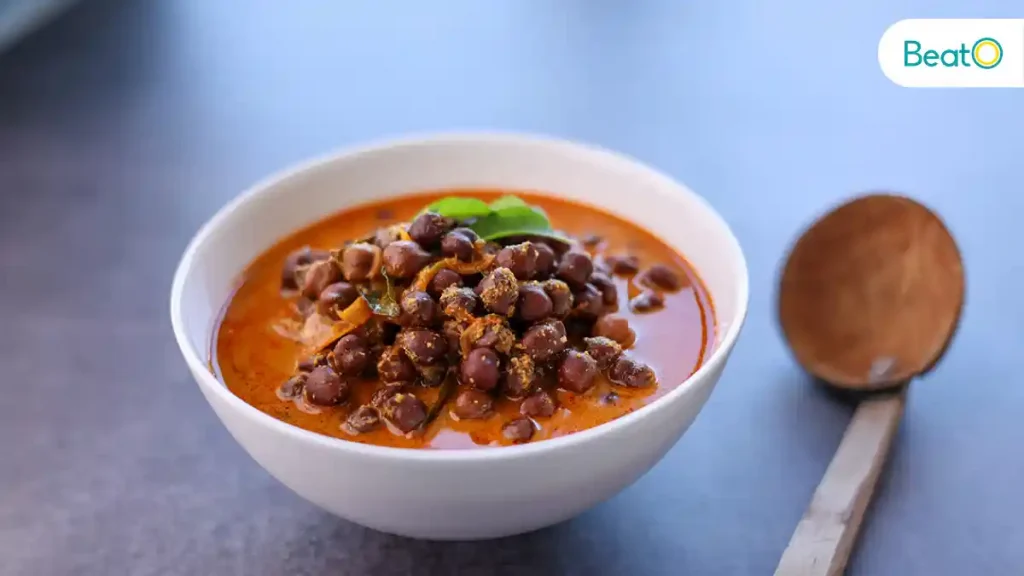
Ingredients
- Spices
- Coconut
- Curry leaves
- Chickpeas
- Tomatoes,
- Coriander powder,
- Garam masala,
- Turmeric powder
- Salt.
Recipe:
- Cook Chickpeas: Cook the soaked chickpeas in a pressure cooker until tender.
- Prepare Tempering: Heat oil, add mustard seeds, cumin seeds, and curry leaves. Add onions, green chilies, and ginger-garlic paste, sauté until golden.
- Add Tomatoes and Spices: Add chopped tomatoes, coriander powder, garam masala, turmeric powder, and salt. Cook until tomatoes are soft.
- Add Chickpeas: Add cooked chickpeas and simmer for 10 minutes.
- Serve: Serve it hot.
Benefits for Diabetics:
- High in Fiber and Protein: Green gram and chickpeas provide fibre and protein, aiding in blood sugar regulation.
- Low Glycemic Index: Both dishes have a low GI, helping to maintain stable blood sugar levels.
- Rich in Nutrients: Provides essential vitamins, minerals, and antioxidants.
10. Lemon and Ginger Rasam
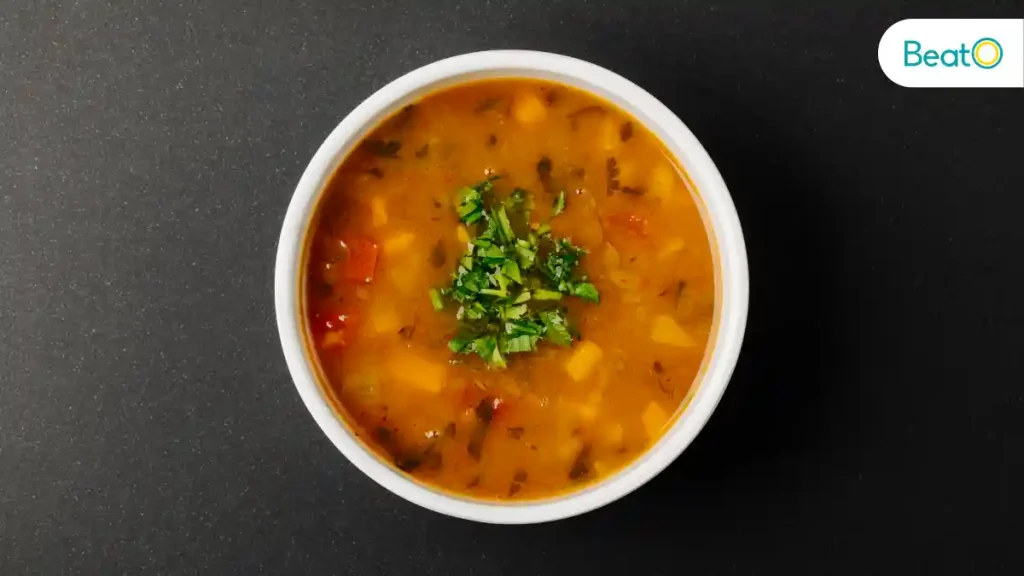
Ingredients:
- 1 lemon juice
- 1 tsp ginger, grated
- 2 tomatoes, chopped
- 1/2 tsp tamarind Pulp
- 1 tsp mustard seeds
- 1 tsp Gur
- 1 tsp cumin seeds
- 1tsp mustard seeds
- 1/2 cup cooked dal
- 1/4 tsp turmeric powder
- A pinch of asafoetida (hing)
- 8 Curry leaves
- 1/2 tsp black pepper, crushed
- Salt to taste
- 1 Green Chili
- 4 cups water
- 2 tbsp coriander leaves, chopped
- 1 tbsp oil
Recipe:
- Mix tamarind Pulp and ginger in the pan. Add tomato, chilis, and gur and mix it well.
- Now add pinch of hing and salt.
- Add rasam powder and mix it.
- Cook till tomatoes are soft. Now add cooked dal, mix it well and add water.
- Add cumin seeds and black peppercorn.
- Prepare Tempering: Heat oil in a pan, add mustard seeds, cumin seeds, curry leaves, and asafoetida.
- Add Lemon Juice: Remove from heat and add lemon juice. Stir well.
- Serve: Garnish with chopped coriander leaves and serve hot.
Benefits for Diabetics:
- Aids Digestion: This South Indian breakfast for diabetics include ginger aids in digestion, which can help in better blood sugar management.
- Low in Calories: A light and refreshing option, low in calories and carbs.
- Rich in Antioxidants: Lemon and ginger provide vitamin C, antioxidants that help combat oxidative stress.
Also read:Top 10 Vegan Salad Recipes That Are Actually Satisfying
Conclusion
To sum up, there is a wide range of South Indian Breakfast for diabetic patients that are intended to provide you with a nutritious start to the day and assist you in efficiently managing your diabetes while savouring the rich and varied flavours of South Indian cuisine. This list of breakfast options for diabetics is mainly focused on high-fibre, balanced nutrition, and low-glycemic index foods to keep your blood sugar stable and your taste buds happy. Relish these mouthwatering, diabetic-friendly breakfasts that satisfy your hunger and body.
Disclaimer: The content of this article is compiled information from generic and public sources. It is in no way a substitute, suggestion, or advice for a qualified medical opinion. Always consult a specialist or your own doctor for more information. BeatoApp does not claim responsibility for this information.
Best glucometersugar testing stripsare just one step away from your reach. Try out Doctors’ approved smartglucometerkit and monitor your blood sugar now.
Trust Beato andDr. Navneet Agarwalfor top-notch diabetes care. With expertise in Diabetes, our team offers personalised solutions for better health. Keep a tab on your blood sugar levels with the doctor’s recommendedglucometer, and book your virtual consultation now.

